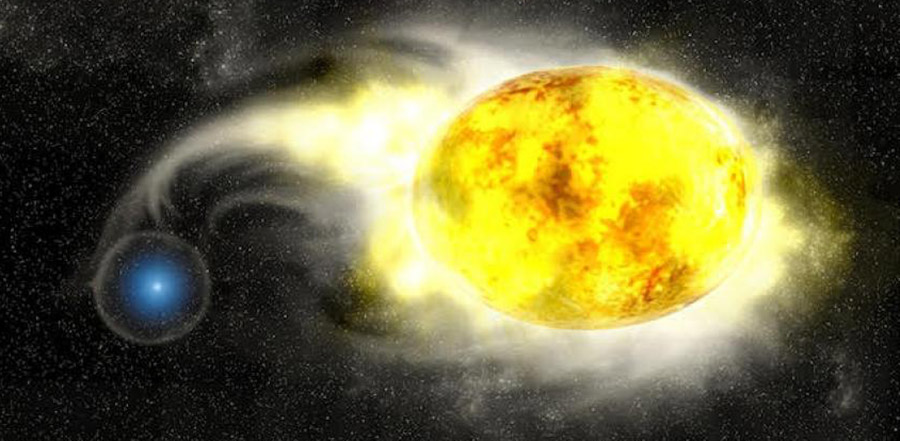Inexplicable explosion: Astronomers have discovered a supernova, the process and causes of which cannot be explained by current models. Because the previous star detected 2.6 years ago by the Hubble telescope is not identical to a rare supernova of type Ib. These eruptions only occur if the star previously lost all hydrogen – but the previous observed star is far too large, cold, and yellow for that.
Usually, at the end of their life cycle, massive stars turn into red giants and explode inside one Supernova primary meltdown. They are also typical of binary star systems Supernovae des Typs Ia, Where a white dwarf absorbs material from a companion star and explodes when a specific mass is exceeded. Both types of supernovae share that there is still some hydrogen in the previous star’s mantle even at its very end.
Supernova without hydrogen
But the 2019yvr supernova, detected in 2019, was different: Spectral analyzes of the light emitted from it revealed that very little hydrogen was involved in this stellar explosion in a spiral galaxy 35 million light-years away. Initially more than 150 days after the supernova, the shock wave of the eruption collided with a cloud of hydrogen that the former star had to lift apparently decades earlier.
At first glance, this stellar explosion was a perfect match for a rare Ib-type supernova. In these, the massive former star throws all hydrogen-containing shells into space before its final collapse. As a result, shortly before the explosion, they were less swollen and hotter than the “regular” red giants. Previous stars of this type Ib supernova fluoresce blue and are over 10,000 ° C.
But how was Supernova 2019yvr? By coincidence, a team led by Charles Kilpatrick of Northwestern University in Illinois succeeded in tracking down the star that preceded the explosion. In the archive of the Hubble Space Telescope, they come across 2.6-year-old deep-space images of this region of the sky, where a bright spot of light can be seen exactly at the location of the late supernova – the former star. .
The former star does not match the explosion
The only strange thing is that this star was very different from the models for a type Ib supernova flagship. Instead of being hot, compressed, and blue, it was amplified to about 320 solar radii and glowed deep yellow. Its temperature was good 6,500 degrees – only half of what was expected. “This is in sharp contrast to the expected previous stars of the type Ib supernova,” according to the researchers’ report. “Instead, this star corresponds closely in temperature and luminosity to the yellow giants, which are progenitors of the collapse of the classical supernova.”
However, the observational data clearly shows that this strange star did not explode in a normal supernova, but in an Ib-type hydrogen deficiency. “We’ve never seen anything like this,” says Kilpatrick. “If a star exploded without hydrogen, it should be blue and very hot. It is almost impossible for a star to be very cold without hydrogen in its atmosphere.” But this former star was nearly free of hydrogen at the time of the explosion.
No scenario applies
How can this contradiction be explained? To find an answer, Kilpatrick and his team go through different scenarios in their study. It is theoretically conceivable that the yellow giant ejected only its hydrogen shell just before the explosion. However, it would have to lose nearly 30 solar masses of hydrogen in less than 2.6 years.
However, according to current models, this is almost impossible and does not explain why no traces of this ejected hydrogen have been found. Because the hydrogen cloud hit by the shock wave of the star’s explosion 150 days later was ejected 44 years before the supernova – that’s too early to explain the observations, astronomers say.
Likewise, a scenario in which the cold yellow surface of the previous star is actually, so to speak, is unlikely simulated by a dense region of intense stellar winds. The star will then appear larger and cooler than it actually is. “But there is no evidence that such dense stellar winds could form in the observed photosphere,” said Kilpatrick and his team.
The double star does not fit either
Could it be that the presumed only star is a binary star system? Astronomers have studied this scenario, too. In most binary star systems, the ancestors of supernovae still retained some hydrogen shortly before the explosion – which would not result in an Ib supernova. But even the few cases in which hydrogen envelopes can be disposed prematurely do not fit the picture:
“Since they are the ancestors of ib-type double stars, one would expect low-mass helium stars. Although these can become slightly enlarged when the shell burns out, they usually remain below 100 solar radii,” Kilpatrick and his team said. On the other hand, the yellow giant of SN2019yvr 320 had at least a solar radius.
“The limits of what is physically possible”
This combination of the former star and the supernova cannot be explained by current theories: “We have looked at every star model that could explain a star like this – but both require that the star still contain hydrogen.” It was not the case, as we know, Kilpatrick says. From the supernova. ”“ This issue reaches to an extent that is physically possible. ”
As astronomers explain, the 2019yvr supernova must have been preceded by a scenario in which a near-ballistic and hydrogen-poor ancestor star formed shortly before the explosion. On the other hand, this process should allow the star to remain unusually cold and large for up to 2.6 years before the supernova. Still, Kilpatrick and colleagues do not have a clear solution to this dilemma.
But they hope better resolution for future telescopes like the Vera C. Rubin Observatory in Chile, which is currently under construction, will provide an answer. “Maybe in four to five years we can learn more about what really happened there,” says Kilpatrick. (Monthly Notices of the Royal Astronomical Society, 2021; Doi: 10.1093 / mnras / stab838)
Source: Royal Astronomical Society

“Total coffee aficionado. Travel buff. Music ninja. Bacon nerd. Beeraholic.”







More Stories
Researchers are particularly fascinated by these exoplanets.
Researchers detect extremely high-energy gamma rays
Anxiety disorders in old age increase the risk of dementia